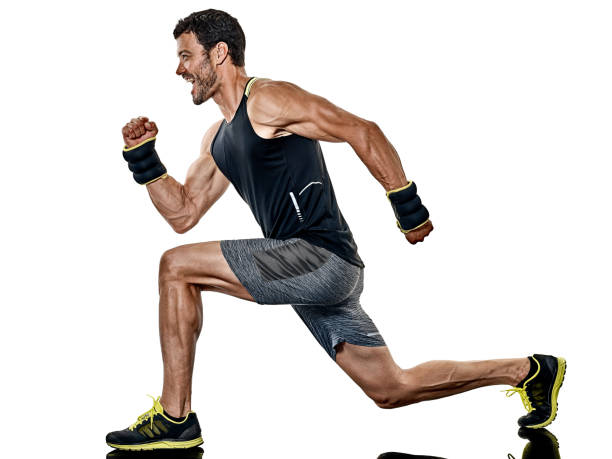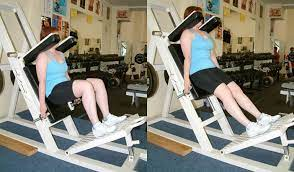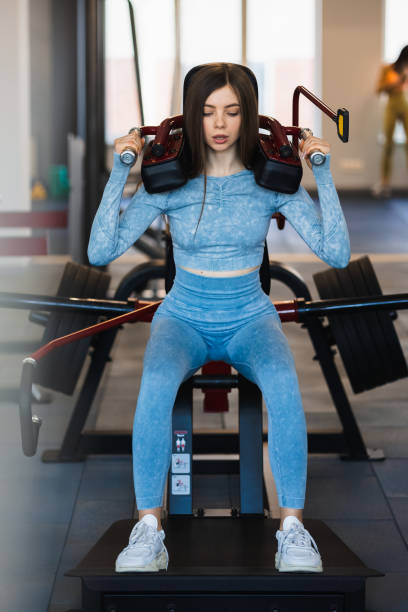
Introduction
Are you looking for a new way to get active and work out your legs? Look no further than the hack squat. This weightlifting exercise is a great option for targeting your leg muscles. Unlike a traditional squat, you’ll hold the weight at the sides or in front of your body. But before you start lifting, it’s important to pay attention to your foot placement. Your feet should be shoulder-width apart, with toes facing straight ahead. By maintaining this position, you’ll stabilize your core and keep your spine neutral. Additionally, it’s vital to keep in mind the proper angle of your feet to distribute the weight evenly across your feet, which will help with balance and provide the appropriate range of motion. With the correct form and technique, the hack squat can be an effective addition to your workout routine.
Understanding Hack Squats
How are Hack Squats Performed?
Hack squats are a lower body exercise that helps build strong quadriceps, hamstrings, and glutes. This exercise can be done using a hack squat machine, barbell, or dumbbell. To perform a hack squat, stand with your feet shoulder-width apart, with your toes pointing slightly outward at a 45-degree angle. Then, slowly lower your body by bending your knees, keeping your upper body straight and chest up until your thighs are parallel to the ground. Push through your heels to return to the starting position and repeat the exercise for the desired reps.

How to Do Hack Squats with Proper Form
Now that you know how to perform hack squats, let’s dive into proper form. The most critical aspect of hack squat form and foot placement is the width and angle of your feet. Your feet should be shoulder-width apart, and your toes should be pointing slightly outwards. The angle of your feet helps activate the correct muscle groups and prevent injury. It is also essential to keep your shoulders back, your core engaged, and your knees aligned with your toes during the exercise. Always lower your body into a deep squat and push through your heels to return to the starting position.
Equipment Needed (if any)
You can use a hack squat machine or a barbell or dumbbell to perform hack squats. A hack squat machine provides a fixed path of movement, which can benefit those new to this exercise or struggle with proper form. A barbell or dumbbell gives you more freedom of movement but requires more stability and safety precautions. Whichever equipment you choose to use, make sure to start with low weight and focus on proper form to prevent injury.
Is the Hack Squat Necessary for a Complete Leg Day Exercise Program?
The hack squat is an excellent exercise to add to your leg day exercise routine, but it is unnecessary for a complete leg day program. Other exercises, such as lunges, leg presses, squats, and deadlifts, target the same muscle groups and can provide similar benefits. The hack squat can benefit those who experience knee pain or have trouble performing squats, as it places less stress on the knee joint.
Hack Squat vs Other Exercises
Hack Squat vs Squat:
The hack squat is a popular exercise similar to the squat but uses a machine instead of free weights. With the hack squat, the position of your feet differs from the squat. While doing the squat, your feet are shoulder-width apart while facing forward. But, during the hack squat, your feet are positioned closer together, about hip-width apart, with your toes pointed outwards. This stance helps your quadriceps and hamstrings to work more efficiently and effectively.
Hack Squat vs Leg Press:
Another machine used for leg development is the leg press. Although it may look similar to the other hack squat machines, it does not involve the exact placement of your feet. During the leg press, your feet are positioned shoulder-width apart with your toes facing forward. Unlike the hack squat, your feet never leave the platform. The leg press is a great exercise for overall leg strength, but it provides a different level of engagement for your quadriceps than the hack squat.
Hack Squat Foot Placement:
Foot placement during the hack squat can improve the exercise’s effectiveness. As previously stated, your feet should be positioned closer together than during the squat and pointed outwards. This stance puts a greater emphasis on your quadriceps. However, it’s also important to note that if your feet are positioned too far forward or too far back free weight squat, it could lead to injury or lack of focus on the targeted muscle groups. It’s essential to make small adjustments until you find the ideal placement for your feet.
Hack Squat vs Other Exercises:
While the hack squat might seem like a small variation to your leg day routine, it’s an excellent addition to challenge your leg muscles. Mixing up your exercises is essential because your muscles can become complacent if you continue the same exercises repeatedly. Incorporating the hack squat into your next leg day can help you mix things up and benefit your quadriceps, hamstrings, and glutes.

Hack Squat Foot Placements and Muscle Activation
1. Regular Stance
The regular stance for a hack squat involves standing with your feet shoulder-width apart. This foot placement targets the overall leg muscles, including the quads, hamstrings, and glutes. However, the focus of traditional squats will be on the entire front side of your legs, giving you an even workout on both legs. Keep your back straight and maintain a 90-degree angle at your knees as you squat down.
2. Narrow Foot Placement
The narrow foot hack squat means to place your feet close together, targeting the outer thighs and glutes. This foot placement is especially useful for those who want to free weight squats focus more on their glutes. Maintaining the same 90-degree angle when performing this move is essential, and you may need to lighten your weight to keep your balance.
3. Feet High vs Low
When your feet are higher up on the platform, the focus of the exercise switches from the quads to the glutes. This move may need to be performed with lighter weights, but it’s a great way to give your glutes an even more exceptional workout than a regular stance would have. When your feet are lower down on the platform, you’ll place more emphasis on your quads.
4. Should Your Feet Be Parallel or at an Angle During the Hack Squat?
Hack squat angle is another aspect that should be considered. Posing like an Avenger (giving Hulk a run for his money) is not the key here. Instead, your feet placement should be at an angle. The feet should be slightly angled outward in most hack squat machines in contrast to a straight foot placement so that you target the inner and outer thighs during the hack squat.
5. How to Modify Foot Placement During Hack Squats
You can test your limits and change your foot placements when you feel comfortable with the regular stance. More focus on quads can be achieved by stretching stride and switching to parallel. Move your feet up the carriage to focus even more on the glutes. One can alter between these types of foot placement as much weight as to achieve muscle activation and create variations according to the fitness goals.

Hack Squat Variations
Whether you’re a beginner or a fitness enthusiast, it’s important to understand the different types of hack squat variations available and how to perform each exercise correctly to prevent injury.
1. Barbell Hack Squat
The barbell hack squat involves standing behind a barbell with your feet shoulder-width apart. You should grab the barbell with both hands, keeping your palms facing your legs. Slowly lower your body into squat by bending your knees and hips. Keep your back straight and your chest up throughout the movement. When you reach the bottom of the barbell squat, push back up to return to the starting position. This variation is great for building overall leg strength.
2. Landmine Hack Squat
The landmine hack squat is a new twist on a classic exercise. You’ll need a landmine attachment to perform this exercise. Start by standing to the side of the landmine and putting the end of the barbell into the landmine attachment. You should then stand with both feet shoulder-width apart and grab the other end of the barbell with one hand. Slowly lower your body into a squat position, keeping your chest and back straight. When you reach the bottom of the squat, push back up to return to the starting standing position. Switch hands on the barbell and repeat.
3. Reverse Hack Squat
The reverse hack squat is performed in a hack squat machine. Instead of facing the machine, you will stand away, with your shoulders against the back pad. You should place your feet shoulder-width apart on the platform and grip the handles on either side of the machine for support. Slowly lower your body into a squat position, keeping your back straight and your chest up. When you reach the bottom of the squat, push back up to return to the starting position. This final hack squat variation is especially useful for targeting your hamstrings.
4. Smith Machine Hack Squat
The Smith machine hack squat is similar to the barbell hack squat but involves using a Smith machine barbell back squat for support. You should stand with your feet shoulder-width apart and your back against the Smith machine bar. Slowly lower your body into squat by bending your knees and hips. Keep your back straight and your chest up throughout the movement. When you reach the bottom of the squat, push back up to return to the starting position.
5. Weight Stack Hack Squat
The weight stack hack squat involves standing on a platform with weights attached to a cable system. You should put your shoulders under the shoulder pads and grip the handles on either side of the platform for support. Slowly lower your body into a squat position, keeping your back straight and your chest up. When you reach the bottom of the squat, push back up to return to the starting position. This variation is great for building quadriceps strength.
Hack Squat Muscles Worked
It might sound strange, but it works wonders for your lower body muscles. This exercise is excellent for building your legs and glutes while targeting hip adductors. So, what exactly are hip adductors? They’re the muscles inside your thighs that help you bring your legs closer together. When you perform a hack squat, these muscles are activated and get a great workout. To get the most out of your hack squat, make sure you’re using the proper stance. A narrow stance will focus more on your hip adductors, while a wider stance will target your glutes and outer thighs. So next time you hit the gym, try the hack squat and feel the burn in your lower body muscles.

Who Should Use Different Hack Squat Foot Placements?
The hack squat machine has two different foot placements: low and wide. Let’s look at who should use these foot placements on exercise machine and why.
Low Foot Placement:
Using a hack squat benefits the low foot placement on the hack squat machine means your feet are positioned together on the platform. This foot placement targets the quadriceps (the muscles on the front of your thigh). If you want to improve the strength and appearance of your quads, you should use the low foot placement on the hack squat machine.
Wider Foot Placement:
A wider foot placement on the hack squat machine means your feet are positioned farther apart on the platform. This foot placement targets the hamstrings (the muscles on the back of your thigh) and glutes (the muscles in your buttocks). If you want to improve the strength and appearance of your hamstrings and glutes, use the wider foot placement on the hack barbell squats and squat machine.
Who Should Use Different Foot Placements?
Now that we know what each foot placement targets let’s look at who should use each foot placement to achieve their fitness goals.
Low Foot Placement:
It would be best to use the low foot placement on the hack squat and leg press machine to build bigger, more muscular quads. This foot placement is great for bodybuilders and powerlifters who want to improve their squatting and leg press performance.
Wider Foot Placement:
If your goal is to build bigger and stronger hamstrings and glutes, you should use the wider foot placement on the hack squat machine. This foot placement is great for athletes who need to improve their lower body power and explosiveness. Runners, swimmers, and jumpers would all benefit from the wider foot placement on the hack squat machine.

Hack Squat Concerns and Alternatives
Hack Squat Alternatives
There are some concerns that going too heavy on hack squats can place a lot of pressure on the knee joint, potentially leading to injury. But don’t worry; you can try plenty of alternatives if you still want to strengthen those lower body muscles. Some popular options include lunges, leg presses, and step-ups. These exercises still give your quads and glutes a serious workout without the added stress on your knees. So, if you’re feeling skeptical about hack squats or want to mix up your leg day routine, try one of these alternatives!
Conclusion
In conclusion, foot placement is a crucial aspect of your hack squat stance and squats. It can influence your stability and the target muscle group you are working on. So, if you want to perform hack squats like a pro, keep your feet shoulder-width apart, toes slightly pointed outward, and firmly planted on the ground. Remember to adjust the foot position according to your variation. Proper foot placement and technique can challenge your lower body and significantly improve your strength and muscle development. Keep practising, and in no time, you’ll be a hack squat master!


Leave a Reply